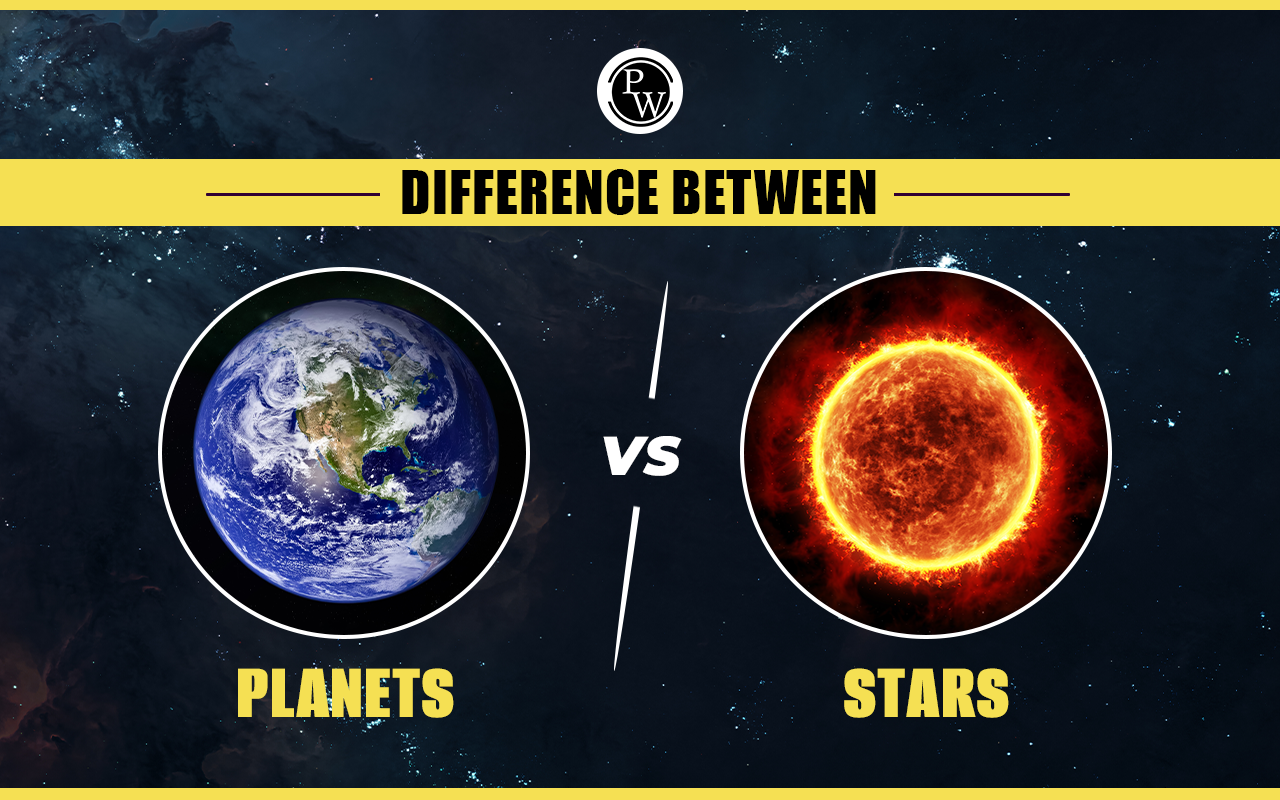
Difference Between Stars and Planets : Fundamental knowledge of astronomy requires an understanding of the difference between stars and planets. This knowledge is important for both enthusiasts and NEET aspirants.
This information is essential for understanding the dynamics of the solar system, recognizing celestial objects in the night sky, and comprehending the universe's life cycle processes. Being a NEET aspirant, one must know about the difference between stars and planets, because questions may come in the exam from this section.| NEET Physics Syllabus | NEET Physics Important Questions with Answers |
| NEET Physics Chapter wise Weightage | NEET Physics MCQs |
| NEET Physics Notes | NEET Physics Formulas |
Red Giants - Stars that have grown into bigger, colder giants after running out of hydrogen fuel. During this phase, they burn helium in their cores and may undergo complex changes in their outer layers.
White Dwarfs - The remains of stars that were once the size of our Sun. They shed their outer layers after using up all of their nuclear fuel, leaving behind a dense core the size of Earth that is primarily made of carbon and oxygen.
Super giants - Massive stars, which surpass the Sun's size and brightness. Before they finally explode in a supernova, they quickly fuse heavier elements, which causes them to grow dramatically in size.
Neutron Stars - A massive star's collapsed core following a supernova explosion. Neutron stars are extremely dense, with the mass of the Sun compressed into a sphere about 20 kilometers in diameter.
Terrestrial Planets - The composition of rocky planets is similar to that of Earth. These include planets like Mercury, Venus, Earth, and Mars, with solid surfaces and dense interiors.
Gas Giants Large planets are made mostly of helium and hydrogen. They lack solid surfaces and have dense atmospheres. Jupiter and Saturn in our solar system are very common examples of gas giants planets.Ice Giants - Planets that contain hydrogen, helium, water, ammonia, and methane. In our solar system, Uranus and Neptune are considered ice giants.
Dwarf Planets - Smaller stars that revolve around the Sun but have not yet cleared other debris from their orbits. Pluto, previously known as the ninth planet, is now classified as a dwarf planet.
Exoplanets - Planets that orbit stars that are not in our solar system. They come in a variety of shapes and sizes, including hot Jupiters, super-Earths, and potentially habitable planets, and they help us understand the universe's planetary diversity.
| Difference Between Stars and Planets | ||
|---|---|---|
| Parameters | Stars | Planets |
| Definition | Self-luminous celestial objects | Non-luminous bodies orbiting a star |
| Shape | Spherical | Spherical (mostly) |
| Size | Vary greatly in size (much larger than planets) | Smaller compared to stars, relatively fixed size |
| Light | Twinkle (due to atmospheric disturbances) | Steady light (do not twinkle) |
| Orbit | Do not orbit other stars | Orbit around a star (e.g., Sun) |
| Energy Source | Nuclear fusion (mainly hydrogen to helium) | Reflect light from a star (e.g., Sun) |
| Visibility on Earth | Visible at night throughout the year | Visible at certain times and locations |
| Examples | Sun (star), Betelgeuse, Sirius | Earth (planet), Mars, Jupiter |
Stellar Classification - NEET aspirants learn about the spectral classification of stars using the mnemonic "Oh, Be A Fine Girl (Guy), Kiss Me." This helps remember the sequence of stellar types i.e. (O, B, A, F, G, K, and M)
Nuclear Fusion in Stars - Understanding the process of nuclear fusion in stars, particularly the proton-proton chain and the CNO cycle, is critical for NEET students interested in stellar energy generation.
Hertzsprung-Russell Diagram - The Hertzsprung-Russell diagram, which depicts the relationship between a star's luminosity and temperature, is covered in the NEET syllabus . This diagram is an excellent tool for comprehending stellar evolution.
Life Cycle of Stars - Students learn about the life cycle of stars, from their formation in nebulae to their eventual fate as white dwarfs, neutron stars, or supernovae. This knowledge is essential for understanding astrophysics concepts.
Black Holes and Stellar Remnants - NEET candidates investigate the fate of massive stars, which results in the formation of black holes or neutron stars. Understanding these strange objects contributes to a thorough understanding of gravitational principles.
Formation and Accretion - Students study accretion in protoplanetary disks, where gas and dust slowly combine to form planets, to gain an understanding of the planet formation process. This concept is related to the formation of celestial bodies in general.
Kepler's Laws - The NEET syllabus includes Kepler's laws of planetary motion, providing insights into the orbits and dynamics of planets around the Sun. Understanding these laws is fundamental to celestial mechanics.
Planetary Atmospheres - Aspirants investigate the various planets' atmospheres, such as the atmosphere that supports life on Earth, the dense atmospheres of gas giants, and the distinct makeup of other celestial bodies.
Planetary Geology - NEET syllabus covers planet geology, including the tectonic processes of Earth, Venus's volcanic activity, and Mars' fascinating landscapes. This information advances our knowledge of planetary evolution.
Exoplanets and Habitability - Since many exoplanets have been found, those interested in NEET investigate whether other planets may be habitable. One of the fascinating aspects of modern astronomy is the hunt for exoplanets in the habitable zone. This post will help the NEET aspirants to understand the real Difference Between Stars and Planets.